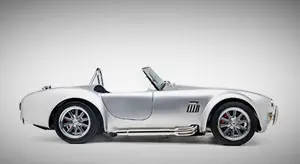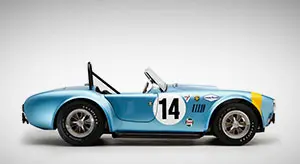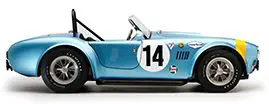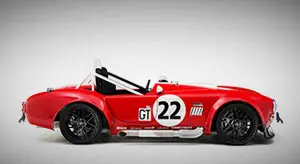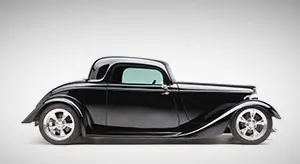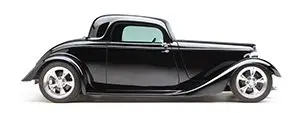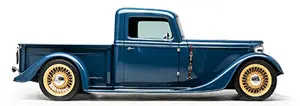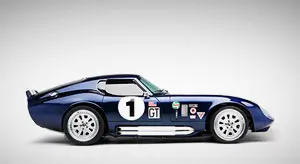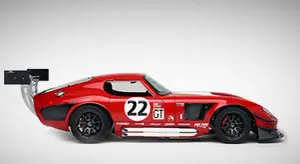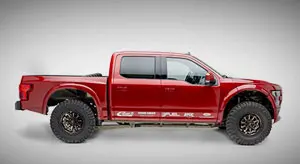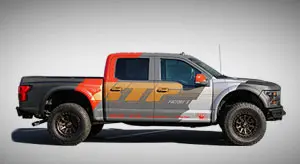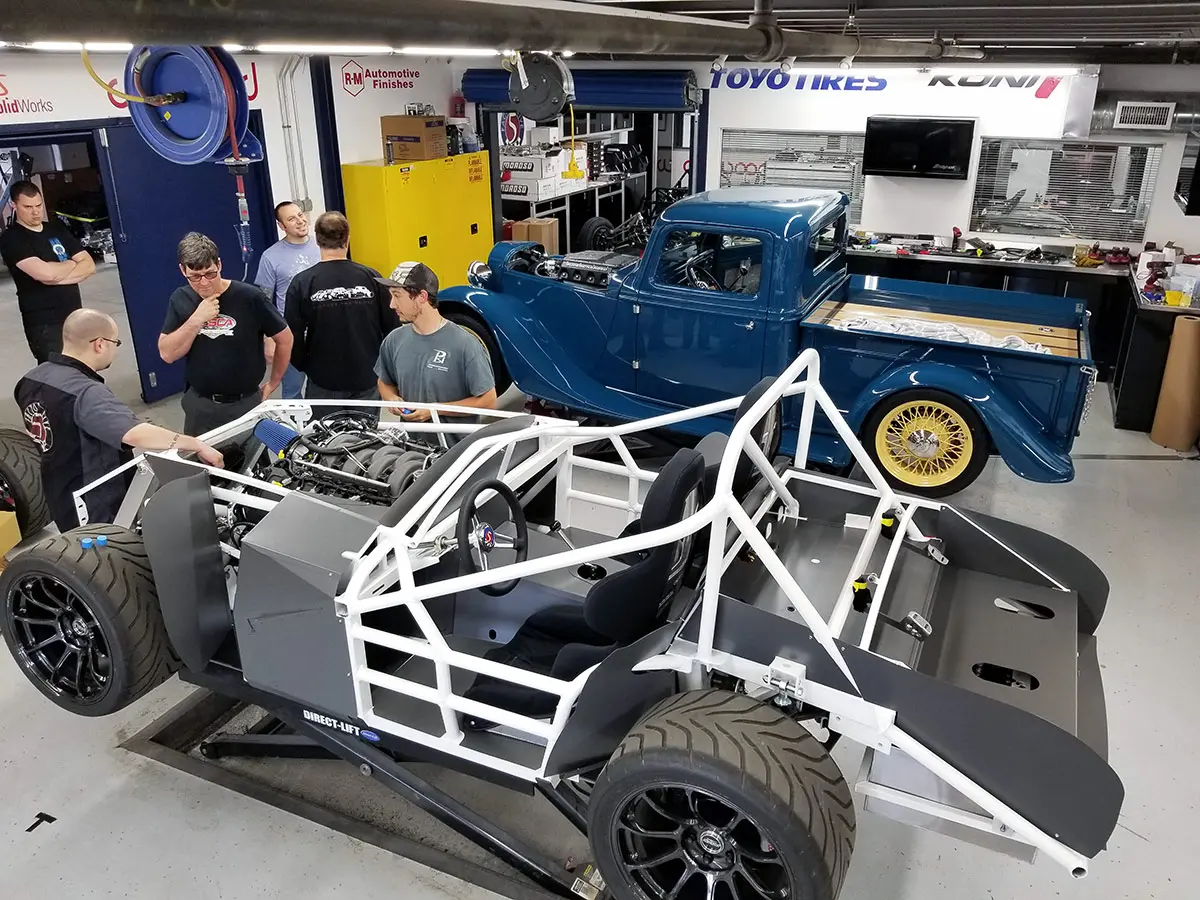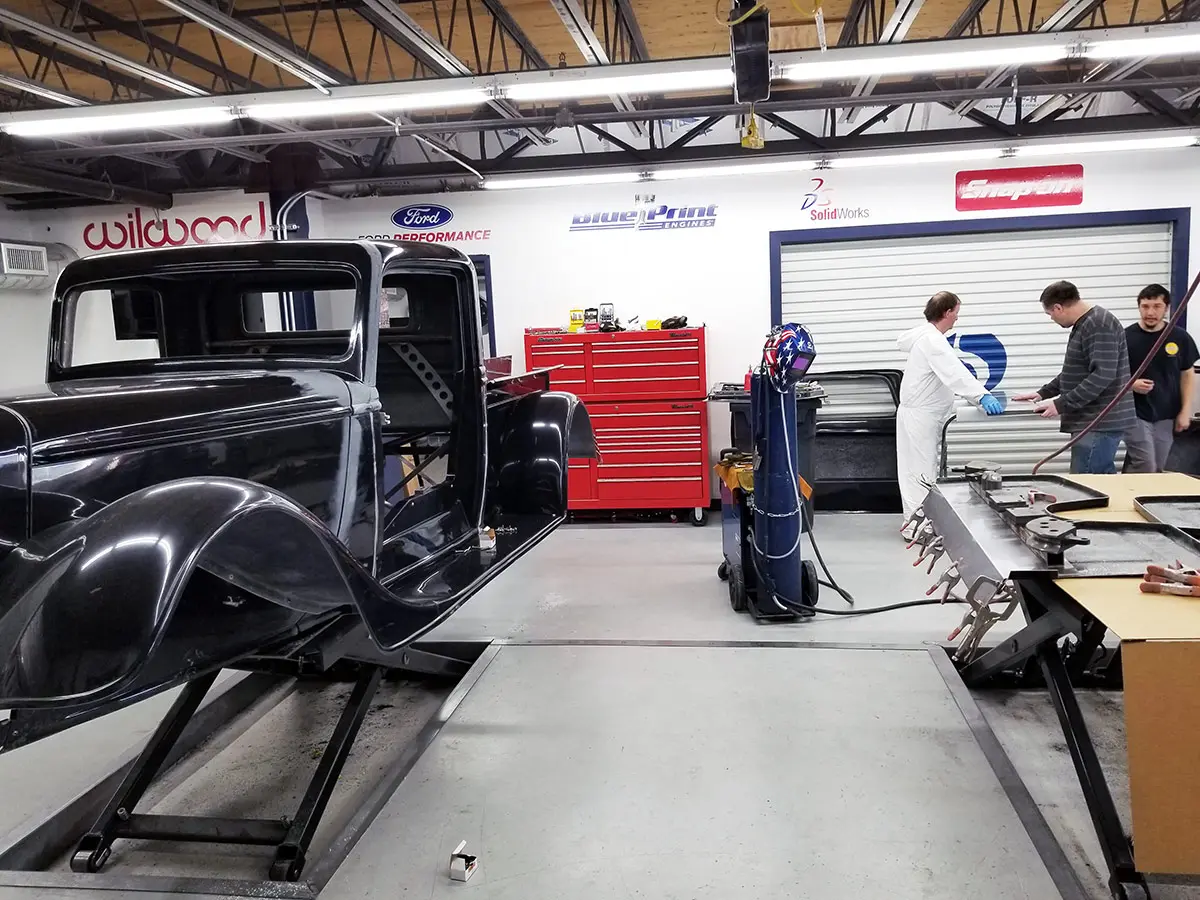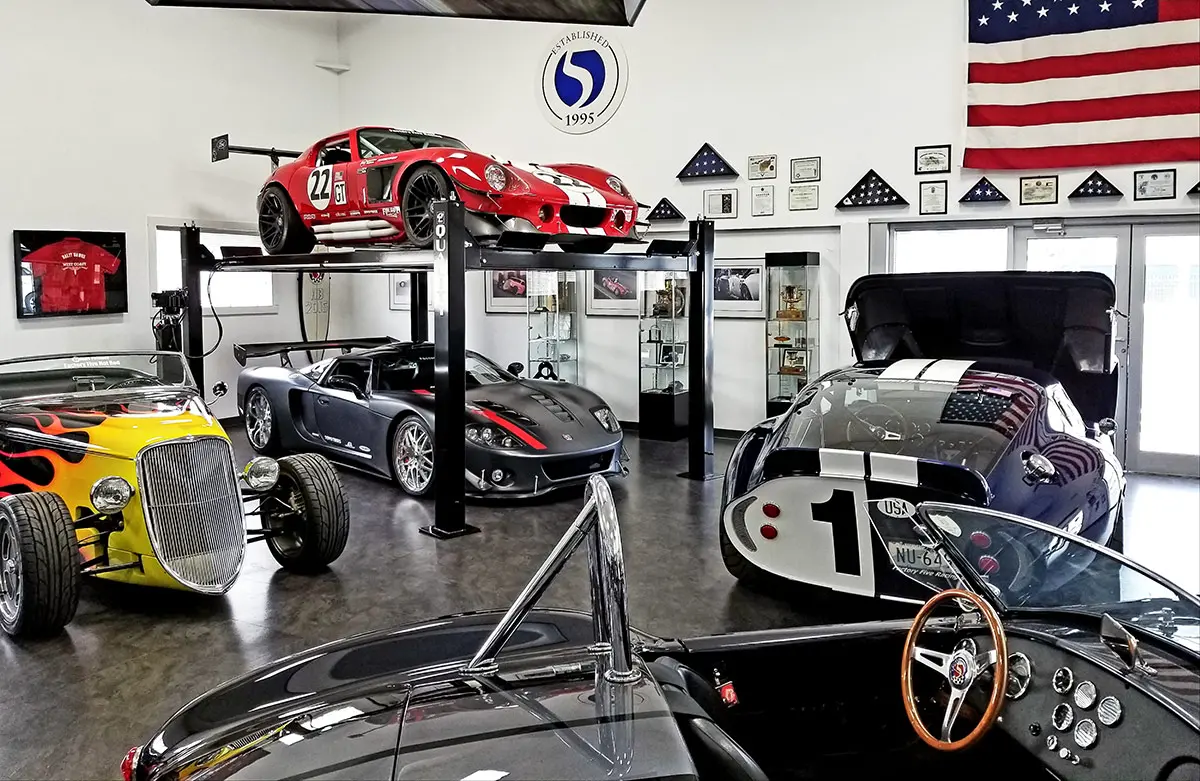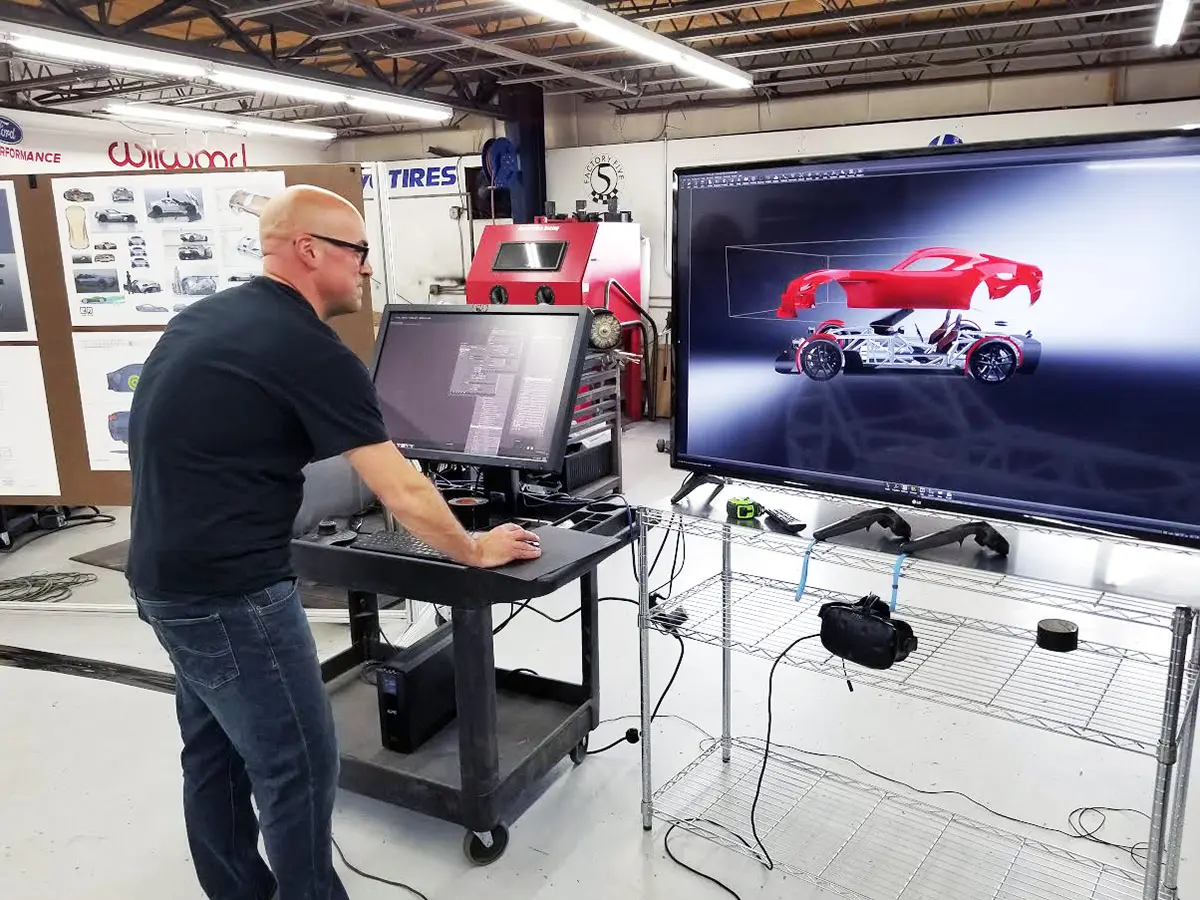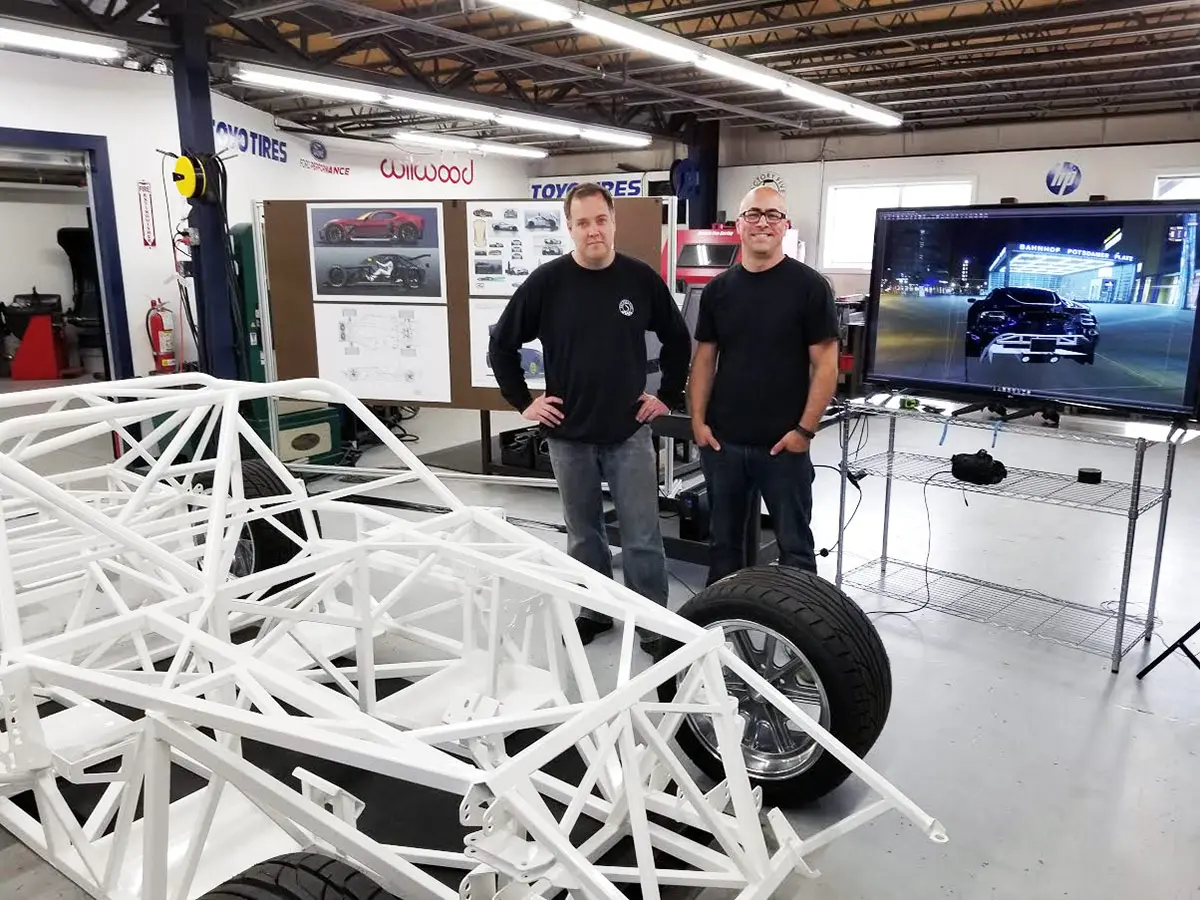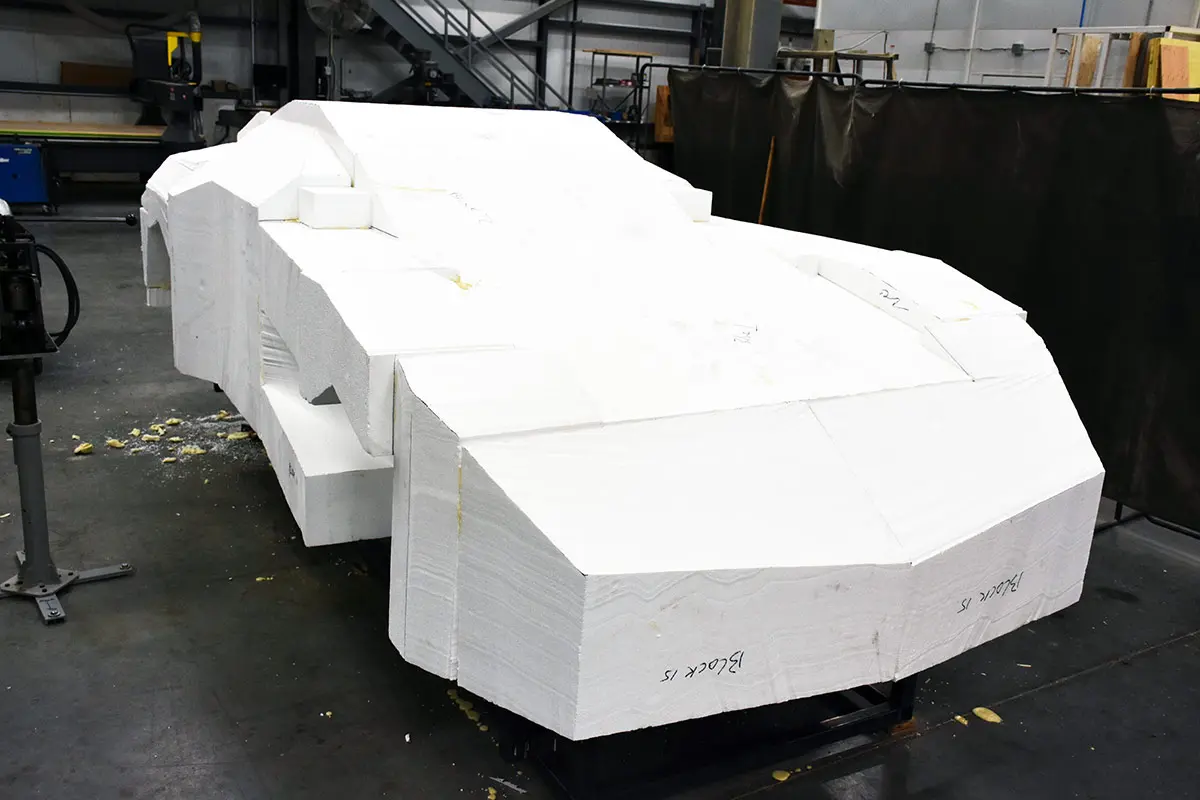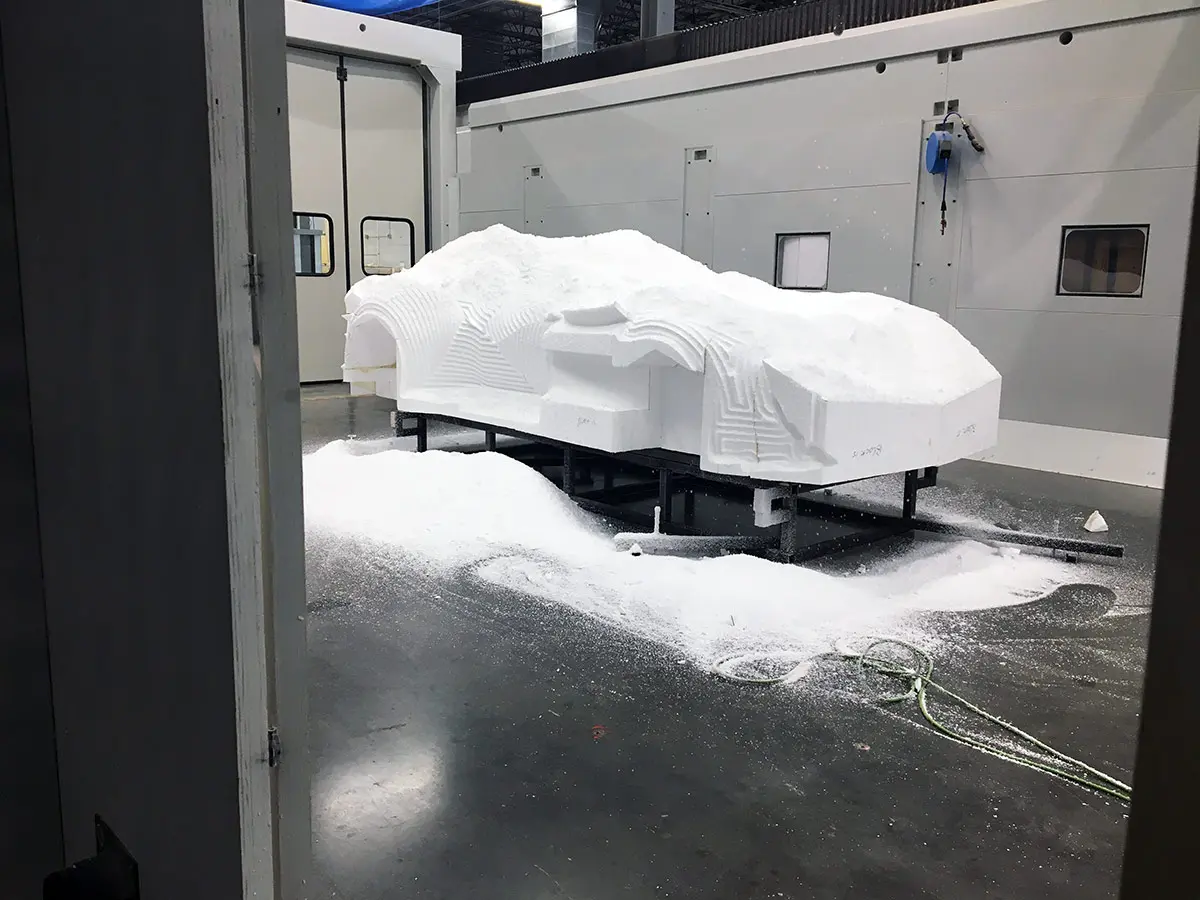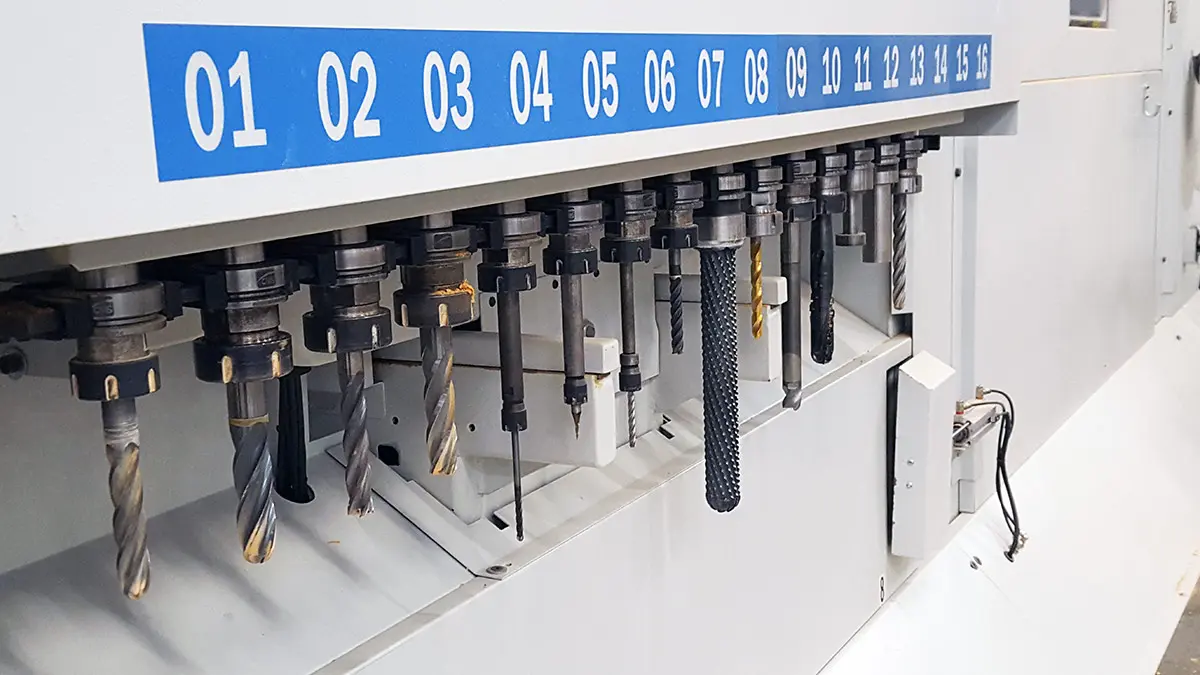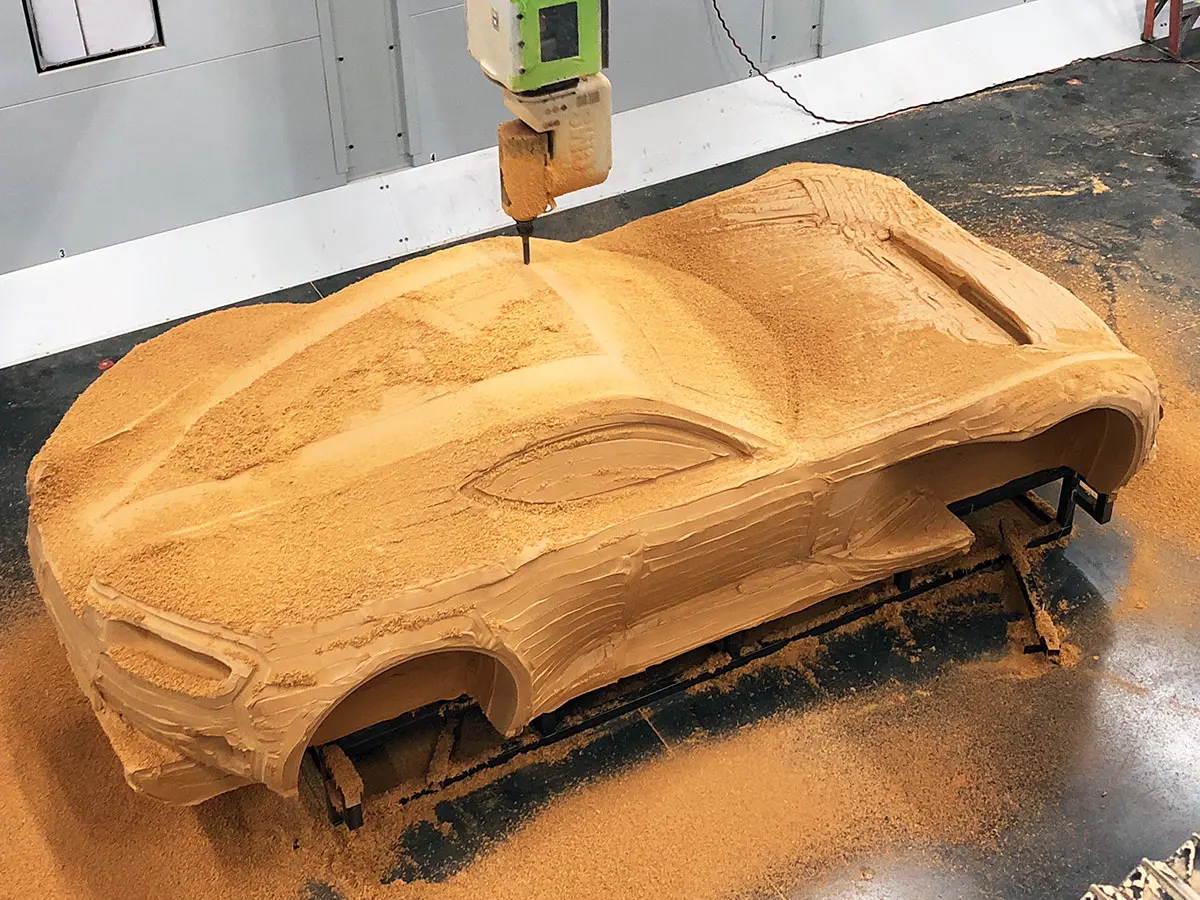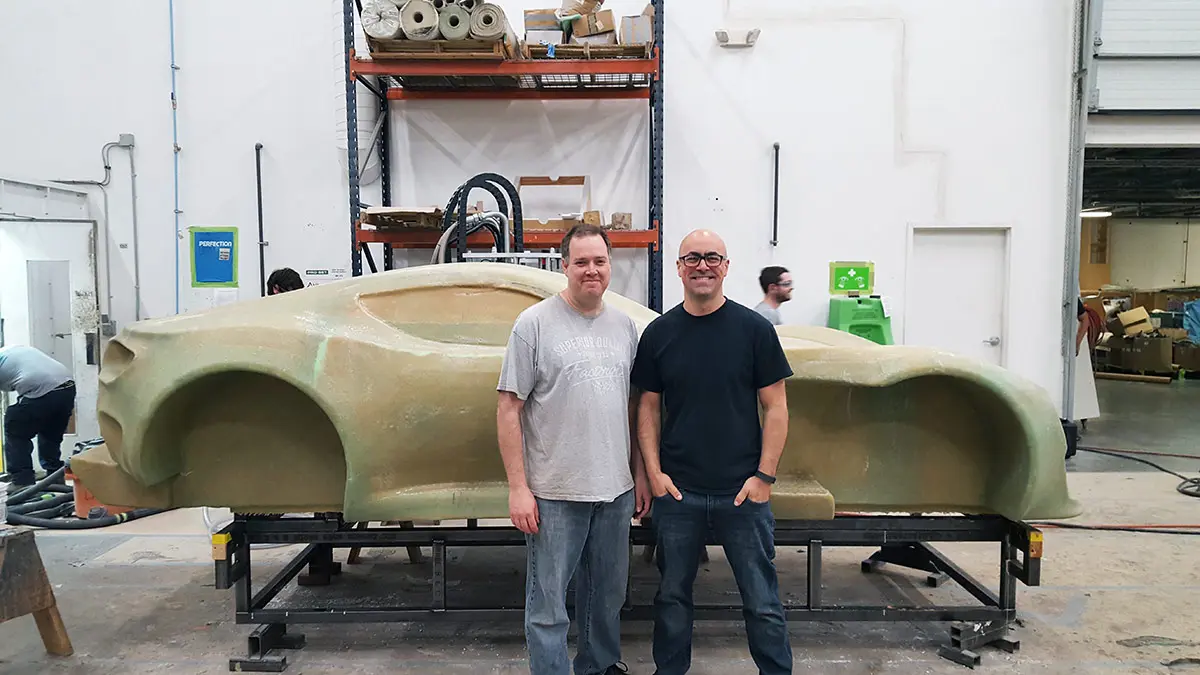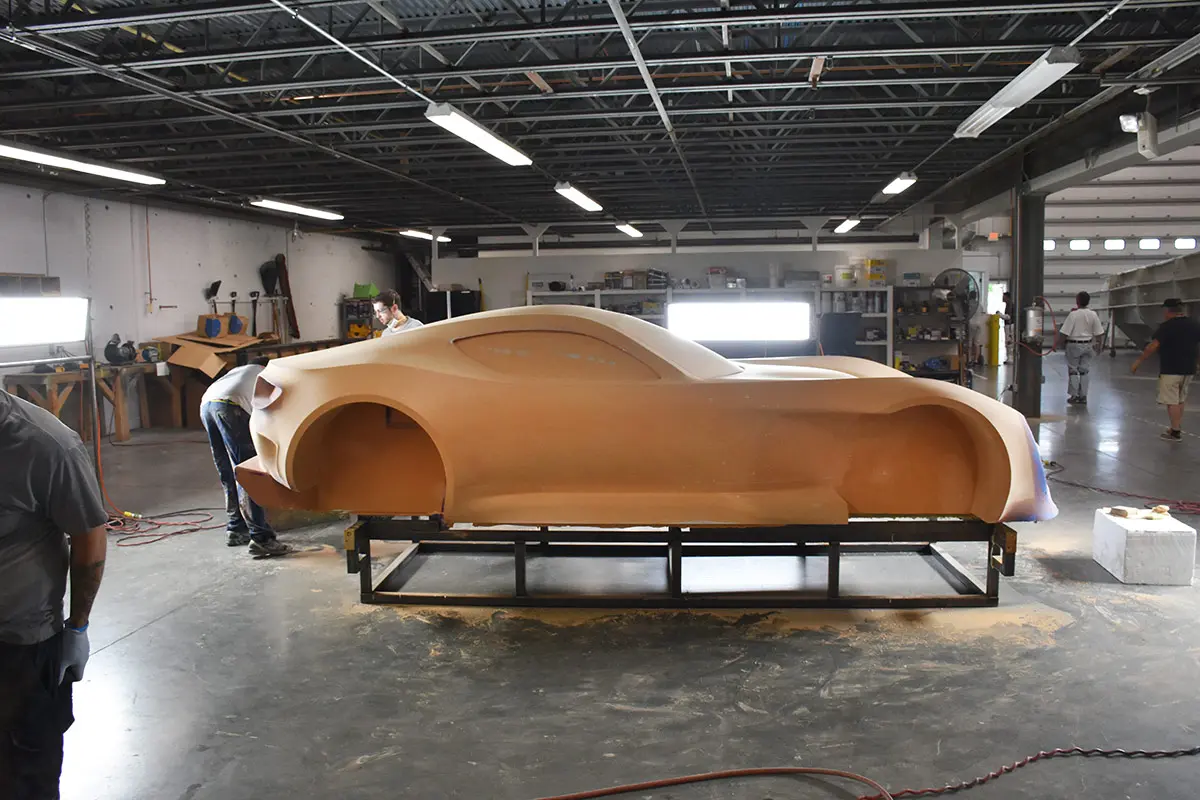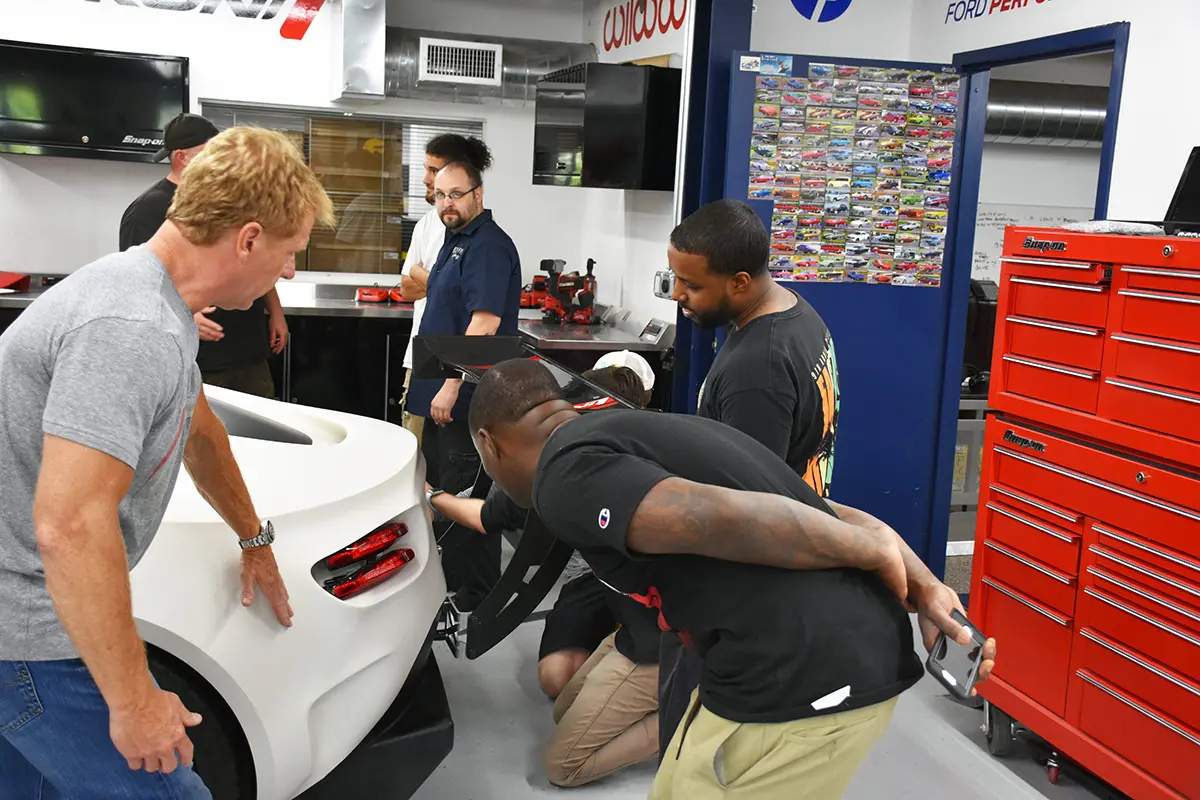
If you don’t want to read this whole post, you can simply watch the video summary above.
For almost 25 years we’ve been shaping composite automobile body panels the same way, by hand. This slow and laborious process of shaping with foam, bondo and clay is tough dirty work that requires great skill. Once the substrate shape is finalized, the mold making process is equally difficult and time consuming. The big news is that this process is rapidly becoming a relic of the past thanks to some serious technology that is becoming a routine commodity and filtering down to small companies with limited budgets. This is our story of how we’ve accomplished this dramatic transition Factory Five Racing.

Hand work is a minimum on the first digitally designed and manufactured body shape for Factory Five.
They say timing is everything in life. I’m not so sure I believe it’s everything, but in business it sure is important. One of the R&D projects that we started about a year ago and have invested a good amount of time and resources into, is an effort to completely reinvent the way we design, develop, and manufacture our vehicle shapes. Basically, I wanted to transition our body shaping bays from manual shaping full size bodies and panels, to designing the shapes on CAD in VR (Virtual Reality) from idea all the way to output and CNC milling of the final shape and tooling. This is already a reality in larger companies, but the bulk of the small custom car business is still using the stone-ages manual process. CAD is nothing new and while we’ve been designing all of our tubular steel chassis, aluminum parts, suspension and drivetrain parts etc, on SolidWorks CAD for a long time, the surfacing and shaping of the bodies has remained a manual process despite our efforts over the years recently to integrate this.
I left Southern California almost 24 years ago and moved to New England to start Factory Five Racing. My oldest daughter Nicole was born two months before Factory Five was born. That was October 1994 and today Nicole has graduated from one of the best business colleges in the world (Babson College) and I am still running Factory Five! The other day I realized that a decision I made way back then is very similar to the one I just recently made. Perhaps the stakes aren’t as high, but the importance to the company is the same.
Back in 1995 I figured the timing was right to apply modern CNC technology into the replica business that was, at the time, mired in hand work and had yet to really incorporate any meaningful level of CAD/CAM technology. I learned CAD working at Boston University Medical School and carried that knowledge and applications into a career in the Biomedical field. In southern California, the company I was working at used AutoCAD in the design and development of medical products and injection mold making tooling. Success starting Factory Five, I decided, would be based on our ability to use these CNC technologies where our competitors were using hand tools. As it would turn out, we were a few years early but would emerge so far ahead of the pack as a result. I remember our competitors laughing at the fact that I was paying twice for machine laser-cut steel as they were paying for product made using hand-held plasma cutters and patterns. The advantages of CNC designed and cut steel parts were across the board and the only downside was cost. The cost would come down fast as laser cutting would soon become just another commodity. Our CAD developed chassis had better strength and used materials with far less waste (so we could buy better materials that cut better and were easier to weld!), and I knew the costs would be pushed down as the technology migrated from high tech companies and applications to smaller companies. I had seen the CNC revolution at work firsthand so I knew it was just a matter of time that it would filter down to the kit car level… Why not be the first? I figured. I even wrote an article for the old “Kit Car” magazine saying that these CAD/CAM technologies were finally filtering down from aerospace and high-tech companies to become affordable for small companies to put to work.. and those who didn’t embrace it would soon be left behind. That’s exactly what happened. Committing to the CNC process paid off and by 2000 we had re-written the book on replicas and taken over the small Cobra kit car market with better, faster, stronger, safer designs that were easier and less expensive to make and had unbeatable reproducibility and reliability. It was all about timing and we entered the kit car world with new tools at the right time. So, from the very beginning we have used CAD for our mechanical assemblies, but the surface shaping of the car bodies has been a work in process.
About a year ago I decided the timing was right to change the way we shape body designs and to go to a fully integrated CAD process. Just like my commitment in 1995 to CAD and CNC for the chassis designs, I wanted to start on the screen, or rather IN it to make decisions about the shape and proportions of our car bodies. Dimensioned real space work, not scale models and sketches is the promise of VR and I wanted to see if that promise was real for a small company with limited resources.
There were a few questions that the process would answer beyond simple time savings. “Would VR deliver a shape that was proper in the real world once output and what would be the correlation (how close would it be)? I’ve learned firsthand that no matter what your sketches and concept renderings look like, regardless of how many scale models you make, no real decisions about whether a car looks good can be made anywhere but in full size. I learned this by sheparding the development of five distinct models of build-it-yourself” cars. With the last three car models we’ve developed, the GTM supercar, the ‘33 Hot Rod, and the 818S, R, and C sportscar, we used some degree of CAD on these car shapes with increasing success. As far back as 2004 we were using CAD on the GTM body, which started out as a concept sketch. The 818 used CAD derived ¼ scale models and we scanned and made molds to some success in the last 4 years or so but the final decisions on shape have always been based on the final full-sized, mostly hand-made, shapes which would be the substrate for the mold plug. The 33 Hot Rod steel body project that we started in 2016 was imported fully into CAD and all the tools were made CNC. The accuracy was great but we already had a shape, so no decisions were made in the virtual design world in the design stage. A year ago, I figured the pieces of the process puzzle were coming together and now I wanted to design in CAD and make decisions to help determine shape in VR without the time and expense of the manual process.
To get to that point where we can make a qualified decision about a car’s shape and proper lines/proportions in clay and foam is, for us, approximately a two-year process. It requires a master shaper and a talented designer guiding the process in a frustrating and painstaking process of add it-take it away, and repeat. The real-world pressure of product release can compromise the process of shaping since the shaping is ALWAYS the longest task (by far) on the project management pert chart. Shaping IS the critical path since all the other work like chassis, powertrain, suspension, interior, NVH testing, race testing, and other mechanical work is always waiting impatiently naked for the shape to be finished. Final vehicle prototype building and testing always goes faster than the body and we are inevitably testing our new models with a rough splash molded shape put on at the last minute over a refined/sorted chassis and powertrain that was ready long before the body.
I needed fully integrated virtual reality design married to precise 3D milling output to reduce the time to make a body shape plug and ultimately accelerate new product development to grow the company. Most (all) of the kit car guys out there are still slaving away covered in dust making fiberglass shapes by hand, no different than Bruce Myers and his knock-off competitors did 50 years ago with his Myers Manx fiberglass VW dune buggys. I decided that the only way we would rapidly and completely integrate CAD into the shaping process was to start a project from the ground up with VR design up front, all the way to full size 7-axis digital milling output for the plug and tooling. Good news was that I had all the right people and talent to complete the project AND a rock star chassis looking for a new modern body shape (our 3rd generation Daytona Coupe). On the talent front I had two of the best mechanical engineers in the industry, Jim Schenck, who designs all of our new products and Jesper Ingeslev, who puts the engineering muscle of those designs into production. I was also personal friends with one of the brightest Solidworks guy in the business, Jeremy Luchini, himself a mechanical engineer and talented designer and who knows the capabilities of our CAD software platform. Jeremy worked at Solidworks for years and headed up their “Let’s Go Design” project. So, rather than start with foam, we started with goggles and VR. The design goals for the car were as unreasonable as it was requiring an all-new (well, new to us) process of 3D creation to manufacturing. I figured if I was going to swing for the fence on a new shaping process, I might as well add some lofty design goals for the new car that would be worthy of our traditional reach exceeding our grasp philosophy. That was eight months ago.
We just completed the first surfaced full-scale body shape. Our 5 axis Fanuc milling machine did not have the software or capabilities to take our final CAD shape and cut the foam so we went to our partners at Symmetrix composite tooling in nearby Bristol RI (they do projects like this routinely for boat hulls and even did a plug for a carbon fiber Funny Car body for my friend Bob Tasca). What we have now is basically a “concept car” but in exact proportion and mounted on a current chassis dimensions (exact). We would add the wheels, glass, trim and other elements on the CNC-milled foam body shape to see if the shape matches what we saw in VR over the months. Also, we will did a formal design review with our small team to discuss changes to the shape and to answer the two original questions:
- Can VR and CAD be used to make product design/shape decisions and to what degree?
- Is the new car a world-class front-engined supercar as called out by the design criteria.
Now that everything from chassis, all the way to the precise dimensioned body has been done on Solidworks and decisions on shape have been made in VR, including not just the look of the car, but also things that matter like visibility and wind resistance/flow simulation for drag and downforce.. now we can determine the connection between the world of VR and the real world of full size vehicle shapes. The completed vehicle shape, with lights and glass, at ride height, with wheels and tires under aggressive wheel arches was ready for evaluation and the project was graded. That is the connection I wanted to quantify. Viewing our 3D VR concept car parked next to its real-world concept car cloned brother shows how close the VR shape is to the real-world car.
What is the conclusion after almost a year of R&D spending and work?
First of all, we can now make decisions on shape and appearance in VR after only weeks rather than months and years of real-world hand shaping. As a result, we are changing all of our shapes over to CAD. This tool will enable us to develop new models and modify existing ones faster and with better accuracy than any hand-shaping process and also lay the foundation for using better manufacturing processes beyond wet lay up composites (that’s a whole other story). I was right in 1995 regarding the timing of CAD/CAM on the chassis and mechanicals. The timing is now right and the technology is now ready for us to fully integrate VR design and CNC shaping into our vehicles and tooling.
Secondly, we’ve come close to an all-new model! While the new GTF model looks pretty radical and comes close to accomplishing the goal of a front engine exotic supercar, I feel it misses the mark by a bit. That’s not a terrible thing. I felt it wasn’t perfect in VR and the real-world output proved that was the same case and the degree to which that was accomplished was exciting. Now the team is refocusing their work away from developing the process (which is now done), to simply refining the car using the new VR/CAD tools. The task now is to make changes to the design of the new GTF to make it hit the design goal of becoming our next front-engined exotic supercar model. I’m unhappy with the entire nose and some quarters. I have expressed the changes I’d like to see to the team. The good news is the team has the talent and now the tools to do this quickly. Look to see a new front-engined modern GTF supercar design utilizing the proven Type 65 Gen 3 chassis and drivetrain in a year at SEMA 2019.

Dave Smith
President, Factory Five Racing, Inc.
P.S. – Many customers have asked me about the future of our GTM. For now, the car is truly remarkable, and remains in production with no plans in the near future to discontinue it.

